When you travel to Siem Reap, you cannot but miss the ancient temple of Bayon, else you will miss the chance to witness one of the most intriguing temples in Southeast Asia.
Built nearly 100 years after Angkor Wat, Bayon served as the centerpiece of the sprawling Angkor Thom, the last and most enduring capital city of the Khmer Empire. Unlike its more famous cousin which was built for Hinduism, Bayon was built as a Buddhist site. It was constructed at the behest of King Jayavarman VII, who broke tradition and adopted Buddhism.
Although it is located close to Angkor Wat we decided to visit Bayon last. We have done little reading about it before the trip so we didn't have many expectations of the temple.
 |
| From afar, Bayon looks like a jagged pile of rocks |
From the dusty parking lot, we saw its large ruins and thought we were just seeing a jagged pile of rocks that stood in our view. We pondered turning back to look for another temple but our driver Pin Ton smiled and pointed to the direction of Bayon. We decided to press further into the ruins. As we approached its entrance, we raised our heads towards the ruins imposing above us. There we saw the towers crowned with gigantic smiling faces. They were everywhere; smiling wide with their eyes half-closed.
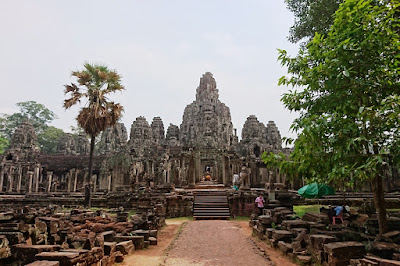 |
| The Bayon taking shape as you approach it |
Bayon originally housed 54 stone towers; now only 37 remain. On each of these towers are carved smiling faces, one facing each of the 4 cardinal directions. It is believed there used to be a total of 216 gigantic faces in Bayon.
The meaning of these faces remains a debate. Some say the faces represent the bodhisattva or the enlightened being. Others believe the faces are of King Jayavarman VII demonstrating the omnipresence of the king similar to a god. Whatever experts believe, the giant smiling faces of Bayon intrigues more than others and its many secrets make it a temple worth visiting.
Here's a look at Bayon's ruins. Let these photos invite you to imagine how the temple would have looked like during one of the most splendid reigns of any kingdom in Southeast Asia.
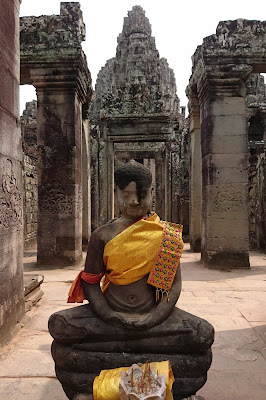 |
| Buddha figure in Bayon |
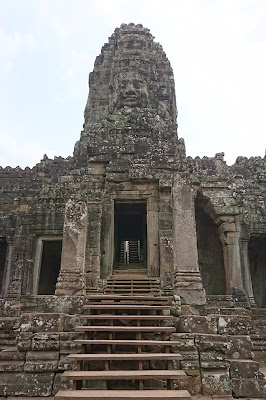 |
| The smiling faces in the towers becoming clear as you ascend the temple staircase |
 |
| A closer look at the tower's faces |
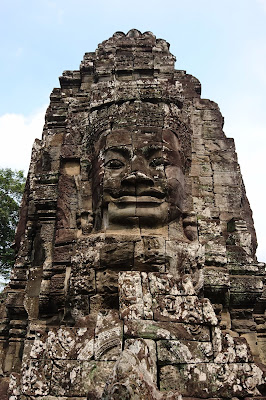 |
| A closer look at the tower's faces |
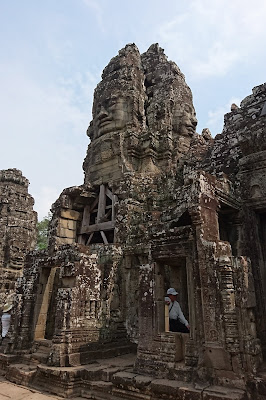 |
| Each tower has carved faces facing 4 directions |
 |
| There are 37 remaining standing towers |
 |
| Bas reliefs in Bayon |
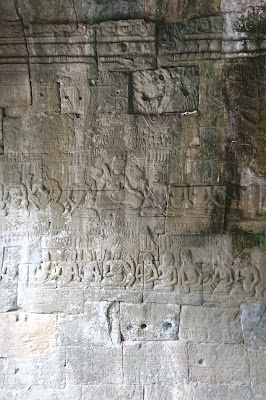 |
| Bas relief of daily life in the Khmer Empire |
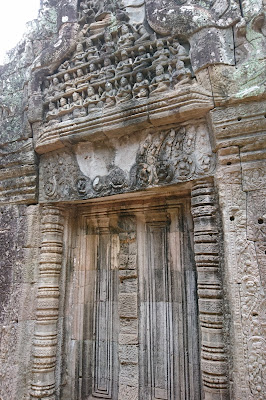 |
| Intricate stone carvings in Bayon Temple |
If you do get a chance to visit Bayon, here are some useful tips:
1. Three levels make up the Bayon Temple. In each level, there are a multitude of gallery mazes, passageways, and stairs. Be careful of low ceilings, narrow walkways, steep staircases, and dim lighting inside.
2. Bayon can be quite crowded during mid-day when tour groups swarm the place. Arrive early to enjoy its serenity and beauty, and to find many photo opportunities.
3. Walkways, platforms, and roped railings have been set up in some areas to protect the temple from further deterioration. Avoid going over these barriers for your safety.
4. Do some reading about the temple before your visit. It helps if you know some of its history and architectural highlights.
5. Look out for small details that are usually missed by most tourists. If within your budget, you may opt to hire a professional tour guide to explain the meanings of the reliefs and carvings found all over the temple.
 |
| Bayon Temple |
So what do you think of Bayon Temple? Please leave your comments or questions in the box below.
Want to know more about our trip to Siem Reap? Please also read:

No comments:
Post a Comment